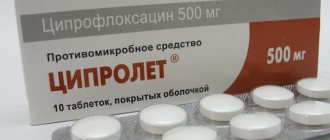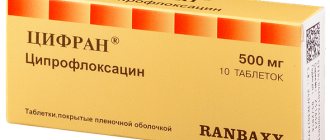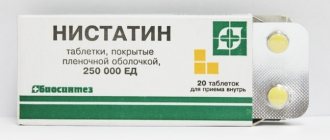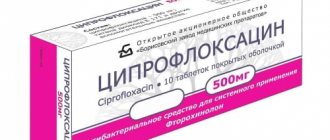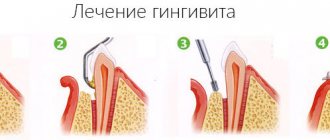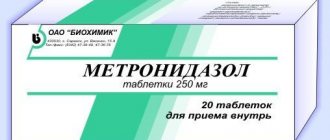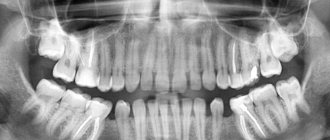Drug Tsiprolet
Tsiprolet antibacterial drops are produced in the form of a clear liquid with a whitish or yellowish tint. Sold in pharmacies in 5 ml dropper bottles.
Compound
The antimicrobial drug includes:
- The active ingredient is ciprofloxacin hydrochloride, which is an antibiotic of the fluoroquinyl group.
- Additional substances:
- sodium chloride;
- hydrochloric acid;
- disodium edetate;
- benzalkonium chloride;
- water for injections.
How it works
The bactericidal effect of Ciprofloxacin is based on the suppression of the bacterial enzyme gyrase, which leads to disruption of protein synthesis in the pathogenic cell and its destruction. As a result of this process, the infectious agent dies. It is prescribed when identifying bacteria that are resistant to antibiotics such as penicillin, tetracycline, cephalosporin and aminoglycosides. Gram-negative (salmonella, enterobacteria, shigella, morganella, chlamydia, etc.) and gram-positive (staphylococci, streptococci, enterococci) bacteria are highly sensitive to Ciprofloxacin. Resistance of microorganisms develops rather slowly to this substance due to the absence of functional units or enzymes that can slow down or inactivate the action of the antibiotic.
Can I put it in my ears?
The drug is often used in the practice of otolaryngologists in the treatment of otitis media, if drugs containing another antibiotic are ineffective. Tsiprolet eye drops are sterile, so if the question arises whether they can be dripped into the ears, any doctor will give a positive answer.
Tsiprolet eye drops - instructions, analogues
Tsiprolet – eye drops with an antimicrobial effect, which are used in the treatment of inflammatory diseases. The antibacterial drug fights various types of pathogens and prevents the development of infections. The main component helps relieve unpleasant symptoms, stops the exacerbation of keratitis and corneal damage.
Dosage form and composition
Anti-inflammatory eye drops Tsiprolet is an ophthalmic agent that is actively used to treat common eye diseases. The main active ingredient is ciprofloxacin, a powerful antibiotic that affects many types of bacteria. It is more effective than penicillin and cephalosporins.
After application to the cornea or eyeball, the antibiotic destroys the membrane of pathogenic bacteria and is integrated into the DNA of the pathogen. The action begins after the first application. In addition to ciprofloxacin, the composition includes the following substances:
- sodium chloride 50 (solution for external use)
- edetate disodium 5%;
- hydrochloric acid;
- benzalkonium chloride solution.
The components enhance the antibacterial effect, have antiseptic properties, and protect the eyes when exposed to germs and dust.
Tsiprolet drops are a liquid substance of a light yellow hue that does not have a pungent odor. The medicine is dispensed in 5 ml plastic bottles with a mini dispenser for convenient use.
Dosage
Anti-inflammatory eye drops Tsiprolet are intended for external use. They are carefully buried in the conjunctival sac, having previously moved the eyelid away with the pads of the fingers. In case of severe suppuration, you can wash the organ of vision from the accumulated exudate, remove crusts and dirt.
If a bacterial infection develops, it is recommended to use the product after 4 hours, 1-2 drops. After 3 days, the dosage is gradually reduced, remaining at the same volume 2 times a day. In case of acute purulent process, during the first 1–3 days the medicine is dripped every 60–90 minutes.
If ulcers and open wounds appear on the cornea, the following dosage is recommended:
- For the first 6 hours, a drop of Tsiprolet is instilled every 15–20 minutes.
- The interval increases to half an hour (except for the sleep period).
- On days 2–14, the composition is used after 4 hours at least 3 times a day.
To prevent complications, you must follow the dosage described by the manufacturer in the instructions for use. The drug is not addictive, so treatment can be extended up to 2-3 weeks.
Side effects
The drug contains many components, so when applied to the cornea or conjunctiva, unpleasant sensations may occur:
- burning;
- increased lacrimation;
- redness of the eyeball;
- sharp pain when trying to look at the light;
- feeling of a speck under the eyelid;
- deterioration of visual acuity.
Read more Instructions for using Acerumen drops
In rare cases, patients complain of a specific metallic taste, stomach discomfort and nausea. If discomfort increases, it is necessary to urgently stop treatment and take antihistamines.
Features of use
We should not forget that Tsiprolet is an antibiotic, so the dosage must be strictly observed. The instructions for the drug indicate the following features of use:
- Do not use during pregnancy.
- The regimen for children is calculated individually by the doctor based on age and severity of inflammation.
- Wearing lenses is not recommended during treatment with drops.
- The product must be applied only to the conjunctival sac so as not to damage the eyeball or lens.
- When using, it is important to ensure that the bottle dispenser does not touch contaminated surfaces.
- Children undergo treatment under the strict supervision of adults and should not apply eye drops on their own.
Pregnancy has become a contraindication due to the high permeability of the antibiotic into placental cells.
The manufacturer of Tsiprolet does not conduct special studies that confirm the complete safety of the components for the fetus or in childhood. In rare situations, the medicine is permitted for use by a woman under the supervision of a physician.
Analogues of Tsiprolet eye drops
Laboratory tests help you choose the right drops, analogues and treatment. The ophthalmologist prescribes bacterial culture of the discharge to determine the type of pathogen. In this case, the drug will help as much as possible without causing an allergic reaction. If there is no effect or intolerance to one of the components, substitutes are used.
Drops provide a similar therapeutic effect and antibacterial effect:
- Tsipromed;
- Rocip;
- Albucid;
- Sulfacyl sodium.
- Oftaquix.
Read more Instructions for using Oftavix eye drops
Children under one year of age can use Tobrex, which has a mild effect on the cornea and does not cause discomfort when instilled. If the patient is pregnant, she is often recommended Oftaquix, a drug from Finnish manufacturers based on levofloxacin. Each prescribed medicine has a different composition and active ingredients. Analogues have different prices from 38 to 240 rubles.
Instructions for use
Depending on the form of otitis and the course of the disease, the doctor selects for each patient a certain frequency of instillation of the drug.
For adults
The mild stage of the disease involves the introduction of 1-2 drops of the drug into the sore ear, with the period between instillations being 4 hours. In acute otitis, the dosage remains the same, and the time between the procedure is reduced to 1 hour, until the patient’s well-being improves. After this, the attending physician adjusts the therapy.
Important: elderly people are prescribed a minimum daily dosage of the drug.
The course of treatment with Tsiprolet is 7-10 days, but in isolated cases it can be increased to 1 month.
For children
For this age group, only a doctor can determine the required dosage and number of installations after conducting an examination and determining the cause of the disease. Due to immature immunity, you cannot stop treatment on your own, even if the symptoms have disappeared. This can cause the development of chronic otitis media.
Treatment with Polydex
Often, combination medications are used to treat otitis media, which contain antibiotics from two different groups. Among them are Polydex ear drops. The active ingredients of this drug are the antibiotics neomycin and polymyxin B, which are effective against many bacteria.
Neomycin is a first-generation antibiotic and has an antibacterial effect: it is effective against many gram-positive (staphylococci, pneumococci) and gram-negative microorganisms; bacterial resistance to it develops slowly. But in the treatment of an illness caused by streptococcal and anaerobic bacteria, neomycin is ineffective.
When applied topically, neomycin and polymyxin B are well tolerated, but are prescribed with caution to pregnant women. Polydex is a local drug that does not enter the bloodstream; if the eardrum is ruptured, it cannot be instilled: this can lead to hearing loss, since neomycin is contraindicated for diseases of the auditory nerve, since it can damage the cells of the middle and inner ear. If there is such a possibility, the doctor will prescribe another medicine to treat the ears.
Side effects
The presence of an antibiotic in the composition of Tsiprolet drops can cause the following adverse reactions:
- dizziness;
- disruptions in taste perception;
- nausea and vomiting;
- diarrhea;
- insomnia or drowsiness.
Local use of the drug causes the following to occur at the instillation site:
- allergic rashes;
- burning;
- itching;
- redness.
The manufacturer of the drug specifies in the instructions that the occurrence of such side effects is rare, but if they occur, you should stop taking this medicine and consult a doctor.
An overdose of Tsiprolet is manifested by the following symptoms:
- convulsions;
- pain in the chest and back;
- inflammation of the colon and blood vessels.
Comparison of the safety of Tsipromed and Levomycetin
The safety of a drug includes many factors.
At the same time, in Tsipromed it is quite similar to Levomycetin. It is important where the drug is metabolized: drugs are excreted from the body either unchanged or in the form of products of their biochemical transformations. Metabolism occurs spontaneously, but most often involves major organs such as the liver, kidneys, lungs, skin, brain and others. When assessing the metabolism of Tsipromed, as well as Levomycetin, we look at which organ is the metabolizing organ and how critical the effect on it is.
The risk-benefit ratio is when the prescription of a drug is undesirable, but justified under certain conditions and circumstances, with the obligatory observance of caution in use. At the same time, Tsipromed does not have any risks when used, just like Levomycetin.
Also, when calculating safety, it is taken into account whether only allergic reactions occur or possible dysfunction of the main organs. In other matters, as well as the reversibility of the consequences of using Tsipromed and Levomycetin.
Precautionary measures
When carrying out therapeutic therapy with Tsiprolet, it is necessary to take into account some special instructions:
- When instilling, follow the rules of the procedure, i.e. Pre-clean your ears and warm the drops to room temperature.
- After the therapeutic manipulation, do not drive a vehicle or perform work that requires increased reaction and increased attention from a person.
- If adverse reactions occur, stop treatment and consult a specialist for advice.
- Do not change your own prescribed treatment regimen to avoid complications.
- If it is necessary to use several local drugs, the interval between them should be at least 5 minutes.
- Use drops with extreme caution in patients predisposed to allergies and children under 12 years of age. From 2 years of age, treatment should be carried out strictly under the supervision of an otolaryngologist.
- Mutual enhancement of the therapeutic effect occurs when combined with metronidazole, clindamycin, vancomycin, ceftazidime, aelocillin and other antimicrobial drugs.
Treatment of otitis media often involves the use of ear drops that contain an antibiotic. Tsiprolet is prescribed in cases where other antibacterial agents have not led to the expected result. This drug is prescribed only by the treating specialist and has a number of contraindications that should be taken into account when choosing it.
What are fluoroquinolones?
Medicines containing ciprofloxacin and ofloxacin are prescribed to kill various infections. Tsiprolet and Ofloxacin are produced in the form of eye and ear drops and tablets. Ciprofloxacin also comes in the form of injection solutions, Ofloxacin - ointments.
Drugs from the fluoroquinolone group are characterized by such a wide spectrum of action that they are used to treat not only ENT organs and eyes, but also when other organs and systems are affected by infection. They are effective for boils, mastitis, abscesses, and are widely used in surgery.
The effectiveness of ciprofloxacin and ofloxacin is determined by the fact that they are able to destroy gram-positive, gram-negative and some other bacteria that are resistant to penicillins, cephalosporins, aminoglycosides (neomycin), as well as antibiotics of other groups. The adaptation of pathogenic organisms to ciprofloxacin and ofloxacin occurs very slowly, so they have time to destroy the pathogens before they develop resistance to the drugs.
The action of Tsiprolet is based on its ability to penetrate the tissues and cells of pathogens, disrupt their DNA synthesis, growth and division. This causes changes in the structure of pathogens, making it impossible to reproduce, resulting in the rapid death of the entire population. Another advantage of ciprofloxacin is that it is able to affect both pathological cells that are in the period of active division and those that are at rest.
Since ciprofloxacin is an antibiotic, it negatively affects not only pathogens, but also microflora. When treating ears, the risk of negative consequences for the body is minimal, since the drug, when used correctly, enters the bloodstream in very small doses.
But you should not forget about contraindications. The medicine should not be instilled into the ears during pregnancy, lactation, or allergies. Among the side effects in the treatment of the outer and middle ear, in reviews you can find references to an allergic reaction in the form of itching, burning, pain in the depths of the auditory canal, in the area of the eardrum.
Sometimes vision may deteriorate, tearing, an unpleasant taste in the mouth, dizziness and other unpleasant symptoms may appear. In this case, treatment with antibiotics of this group must be stopped and an alternative medicine must be found.
